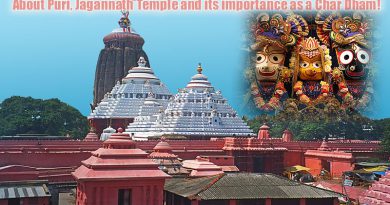Know About Pilgrimage!
Know About Pilgrimage – A Divine Journey Or Search For Moral Or Spiritual Significance!
A pilgrimage is a divine journey or search for moral or spiritual significance.
A pilgrimage is a divine journey to beatify our life with blessings of almighty and nature. Every religion believes in the Pilgrimage and its importance. Basically it has spiritual significance for every religion to search their peaceful, moral and ultimate goal of their life.
Generally, it is a divine visit to an ancient shrine, temple, mosque, or other locations of importance to a devotee’s beliefs and faith all around the world. Many times it can be a symbolic journey into someone’s own beliefs.
Many religions have spiritual and divine significance to particular places as the place of birth or death of founders or saints, or to the place of their “calling” or spiritual awakening, or of their association with the divine, to locations where miracles were performed or observed, or locations where a god is said to live or be “housed,” or any site that is seen to have an exceptional spiritual powers. Such locations may be remembered with shrines or temples that devotees are motivated to visit for their own spiritual and divine gain: to be healed or have questions answered or to achieve some other divine benefits. A human being who makes such a trip is called a pilgrim.
Hinduism:
Hinduism is deep rooted traditional and cultural Hindu religion with its peculiar customs, faith and holiness.
Hinduism is the foremost religion in the way of life in the Indian subcontinent and encompasses of many diverse traditions. It includes Shaivism, Vaishnavism and Shaktism among plenteous other traditions, and a wide spectrum of laws and prescriptions of “daily morality” based on karma, dharma, and societal norms. Hinduism is a categorization of distinct intellectual or philosophical points of view, rather than a rigid, common set of beliefs.
Hinduism has been called the “oldest religion” in the world, and some believers refer to it as Sanātana Dharma, “the eternal law” or the “eternal way” beyond human origins. It recommends the “eternal” duties, such as honesty, mercy, purity, self-restraint, among others.
Hindu practices include daily rites such as puja (worship) and recitations, annual festivals, and occasional pilgrimages. Select group of ascetics leave the common world and engage in lifelong ascetic practices to attain moksha.
Hindu manuscripts (books) are classified into Śruti (“revealed”) and Smriti (“remembered”). These books discuss theology, philosophy, mythology, Vedic yajna and agamic rituals and temple building, among other topics. Chief scriptures include the Vedas, Upanishads (both Śruti), Mahabharata, Ramayana, Bhagavad Gita, Puranas, Manusmṛti, and Agamas (all smriti).
Hinduism, with about one billion followers is the world’s third largest religion, after Christianity and Islam.
There are a numerous Hindu places of pilgrimage are associated with legendary events from the lives of a range of gods. But in most cases they are holy cities, rivers, lakes, and mountains. Hindus are motivated to carry out pilgrimages during their lifetime, though this practice is not considered absolutely compulsory. Most Hindus visit sites within their region or milieu.
The Indian cities of Allahabad, Varanasi, Ayodhya, Mathura, Haridwar, Kanchipuram, Ujjain and Dwarka are said to be the main Pilgrim cities in Hinduism; as stated in the Vedas. Of these Varanasi; Uttar Pradesh is considered the Holiest prehistoric site and it is considered by many to be the most sacred place of pilgrimage for Hindus.
Kumbh Mela
Kumbh Mela is the major pilgrimage in the Indian history. Kumbh Mela is also recognized with the biggest gathering of humans in the entire world. The Kumbh Mela (the “pitcher festival”) is one of the holiest of Hindu pilgrimages that is held every four years; the location is rotated among Allahabad, Haridwar, Nashik, and Ujjain.
Char Dham (Famous Four Pilgrimage sites)
The four divine sites Puri, Rameswaram, Dwarka, and Badrinath (or alternatively the Himalayan towns of Badrinath, Kedarnath, Gangotri, and Yamunotri) compose the Char Dham (four abodes) pilgrimage circuit.
Old Holy cities as per Puranic Texts
Varanasi formerly known as Kashi, Allahabad formerly known as Prayag, Haridwar – Rishikesh, Mathura -Vrindavan, Pandharpur, Paithan and Ayodhya.
Major Temple cities
Puri, which hosts a major Vaishnava Jagannath temple and Rath Yatra celebration; Katra, home to the Vaishno Devi temple; Three comparatively recent temples of fame and huge pilgrimage are Shirdi, home to Sai Baba of Shirdi, Tirumala – Tirupati, home to the Tirumala Venkateswara Temple; and Sabarimala,where Swami Ayyappan is worshipped.
Shakti Peethas
Another important set of pilgrimages are the Shakti Peethas, where the Mother Goddess is worshipped, the two principal ones being Kalighat and Kamakhya.
Buddhism
Buddhism is a nontheistic religion that covers an assortment of traditions, beliefs and practices largely based on teachings attributed to Siddhartha Gautama, who is universally known as the Buddha, meaning “the awakened one”. As per Buddhist tradition, the Buddha lived and taught in the eastern part of the Indian subcontinent sometime between the 6th and 4th centuries BCE.
The Buddhist way of life of peace, loving kindheartedness and wisdom can be just as significant today as it was in ancient India. Buddha explained that all our troubles and pain arise from baffled and negative states of mind, and that all our happiness and good fortune arise from peaceful and positive states of mind. Buddha meditating Buddha taught methods for gradually overcoming our negative minds such as anger, jealousy and ignorance, and developing positive minds such as love, compassion and wisdom.
Meditation is at the heart of the Buddhist way of life. It is fundamentally a method for understanding and working on our own mind. We first learn to identify our different negative mental states known as ‘delusions’, and learn how to develop peaceful and positive mental states or ‘virtuous minds’. Then in meditation we overcome our delusions by becoming familiar with virtuous minds. Out of meditation we try to maintain the virtuous minds we have developed and use our wisdom to solve the problems of daily life. As our mind becomes more positive our actions become more constructive, and our experience of life becomes more satisfying and beneficial to others. Anyone can learn basic meditation techniques and experience great benefits, but to progress beyond basic meditation requires faith in the Three Jewels – Buddha, Dharma and Sangha. Usually people find this develops naturally as they experience the benefits of their meditation practice.
The most significant sites of pilgrimage in Buddhism are situated in the Gangetic plains of Northern India and Southern Nepal, in the area between New Delhi and Rajgir. This is the area where Gautama Buddha lived and taught, and the main sites connected to his life are now important places of pilgrimage for both Buddhists and Hindus. But, a lot of countries that are or were mainly Buddhist have shrines and places which can be visited as a pilgrimage.
The Buddhist’s pilgrimage includes:
Lumbini: Buddha’s birthplace (in Nepal)
Bodh Gaya: place of Enlightenment
Sarnath: where he delivered his first teaching
Kusinara: (now Kusinagar, India) where he attained mahaparinirvana (died).
Additional pilgrimage sites in India and Nepal connected to the life of Gautama Buddha are: Savatthi, Pataliputta, Nalanda, Gaya, Vesali, Sankasia, Kapilavastu, Kosambi, Rajagaha, Varanasi, Sabari mala.
Further famous sites for Buddhist pilgrimage include:
India: Sanchi, Ellora, Ajanta.
Thailand: Sukhothai, Ayutthaya, Wat Phra Kaew, Wat Doi Suthep.
Tibet: Lhasa (traditional home of the Dalai Lama), Mount Kailash, Lake Nam-tso.
Cambodia: Angkor Wat, Silver Pagoda.
Sri Lanka: Polonnaruwa, Temple of the Tooth (Kandy), Anuradhapura.
Laos: Luang Prabang.
Myanmar: Bagan, Sagaing Hill.
Nepal: Boudhanath, Swayambhunath.
Indonesia: Borobudur.
China: Yung-kang, Lung-men caves. The Four Sacred Mountains
Japan:
Shikoku Pilgrimage, 88 Temple pilgrimage in the Shikoku island. Japan 100 Kannon, pilgrimage composed of the Saigoku, Bandō and Chichibu pilgrimages. Saigoku 33 Kannon, pilgrimage in the Kansai region. Bandō 33 Kannon, pilgrimage in the Kantō region. Chichibu 34 Kannon, pilgrimage in Saitama Prefecture. Chūgoku 33 Kannon, pilgrimage in the Chūgoku region. Kumano Kodō Mount Kōya.
Sikhism:
Sikhism, or known in Punjabi as Sikhi is a monotheistic religion founded during the 15th century in the Punjab region of the Indian subcontinent, by Guru Nanak and continued to progress through the ten successive Sikh gurus (the eleventh and last guru being the holy scripture Guru Granth Sahib. The Guru Granth Sahib is a collection of the Sikh Guru’s writings that was compiled by the 5th Sikh Guru). It is the fifth-largest organized religion in the world, with about 30 million adherents. Punjab, India is the only state in the world with a majority Sikh population.
The central teaching in Sikhism is the belief in the concept of the oneness of God. Sikhism considers spiritual life and secular life to be intertwined. Guru Nanak, the first Sikh Guru established the system of the Langar, or communal kitchen, in order to demonstrate the need to share and have equality between all people. Sikhs also believe that “all religious traditions are equally valid and capable of enlightening their followers”. In addition to sharing with others Guru Nanak inspired people to earn an honest living without exploitation and also the need for remembrance of the divine name (God). Guru Nanak described living an “active, creative, and practical life” of “truthfulness, fidelity, self-control and purity” as being higher than a purely contemplative life. Guru Hargobind, the sixth Sikh Guru, established the political/temporal (Miri) and spiritual (Piri) realms to be mutually coexistent.
According to the ninth Sikh Guru, Tegh Bahadhur, the ideal Sikh should have both Shakti (power that resides in the temporal), and Bhakti (spiritual meditative qualities). Finally the concept of the baptized Saint Soldier of the Khalsa was formed by the tenth Sikh Guru, Gobind Singh in 1699 at Anandpur Sahib. Sikhs are expected to embody the qualities of a “Sant-Sipāhī”—a saint-soldier. Sikhs are anticipated to have control over the so-called “Five Thieves” dispel these by means of the so-called “Five Virtues”.
The Sikh religion does not place great importance on pilgrimage. Guru Nanak Dev was asked “Should I go and bathe at pilgrimage places?” and replied: “God’s name is the real pilgrimage place which consists of contemplation of the word of God, and the cultivation of inner knowledge.”
But, Amritsar and Harmandir Saheb (the Golden Temple) became the spiritual and cultural centre of the Sikh faith, and if a Sikh goes on pilgrimage it is usually to this place.
Harmandir Sahib, or Darbar Sahib (also known as the Golden Temple), is culturally the most significant holy place in Sikhism, considered the spiritual and cultural centre of Sikhs. It is located in Amritsar, Punjab, India. It is one of the oldest Sikh Gurdwaras. It is located in the city of Amritsar, India, which was established by Guru Ram Das, the fourth guru of the Sikhs and the city was also built around the shrine, known as “Guru Di Nagri” meaning city of the Sikh Guru. It is made from white marble to keep the ground cool and nice. It was later laid with real Gold which was provided by the emperor of Sikh Empire, Maharaja Ranjit Singh.
One more important place is the village of Nankana Sahib in Pakistan,the birthplace of Guru Nanak, founder of Sikhism. Each of Nankana Sahib’s Gurdwaras is associated with special events in Guru Nanak Dev’s life. The town remains an important site of pilgrimage for Sikhs globally. Punjab province of Pakistan is also the location of many important religious and historical sites for Sikhs, including the place of martyrdom of fifth Sikh Guru, Guru Arjan Dev. Many other important Sikh Shrines are located in the Punjab state of India as well as other parts in India.
Jainism:
Jainism, usually known as Jaina Shasana or Jaina dharma , is an Indian religion that prescribes a path of ahimsa—nonviolence—towards all living beings, and emphasizes spiritual interdependence and parity between all forms of life. Practitioners believe that nonviolence and self-control are the means by which they can get liberation. Ascetism is thus a major focus of the Jain faith. The three main principles of Jainism are Ahimsa (Nonviolence), Anekantvad (Non-Absolutism) and Aparigraha (Non-Possessiveness).
Jainism is one of the oldest religions in the world. Jains conventionally trace their history through a succession of twenty-four propagators of their faith known as tirthankaras with Rishabh as the first and Mahāvīra as the last of the current era.
Jainism is a religious minority in India, with 4.2 million believers, and there are immigrant communities in Belgium, Canada, Hong Kong, Japan, Singapore, and the United States. The population of the Jain community across the world is around 6.1 million.
Jainism is a Dharmic religion comparable in belief and practice to other Indian traditions, particularly Buddhism as well as Hinduism – the former to which it shares many comparable ties and some near – identicalities philosophically, doctrinally and historically.
The Palitana temples on Mount Shatrunjaya, located by the city of Palitana, in Bhavnagar district, Gujarat, India are considered one of the holiest places for Jains. Jains believes that a visit to this group of temples is essential once in a life time to achieve nirvana or salvation, much like the Hajj for Muslims.
Shikharji or Śrī Sammed Śikharjī, also known as the Parasnath Hill, located in Giridih district in Jharkhand, India, is a main Jain pilgrimage site and is one of the most holy place for Jains in the world. According to Jain belief, twenty of the twenty-four Tirthankaras (teachers of the Jains) attained Moksha (Nirvana) from this place. Parasnath Hill, with a height of 1,350 metres (4,430 ft)), is the highest mountain in the state of Jharkhand. The number of Tirthankars who attained nirvana at Shri Sammet Shikharji is 20. For each of them there is a shrine on the hill.
The hill is also known as Parasnath, a name derived from Parshva, the 23rd Tirthankara who attained Nirvana there. The current temple is not very old, although the idol in the main temple is prehistoric. The Sanskrit inscriptions at the foot of the images indicate that they were installed in the temple in 1678 AD.
We also update information regularly which will help all to solve their Pilgrimage related various issues and queries.
Trust us, your hunt for Pilgrimage related information should end here.
If you need any help regarding Pilgrimage or Pilgrimage related information, please leave your message at our Pilgrimage Help Centre.
All this information is free and only for informational purpose.




